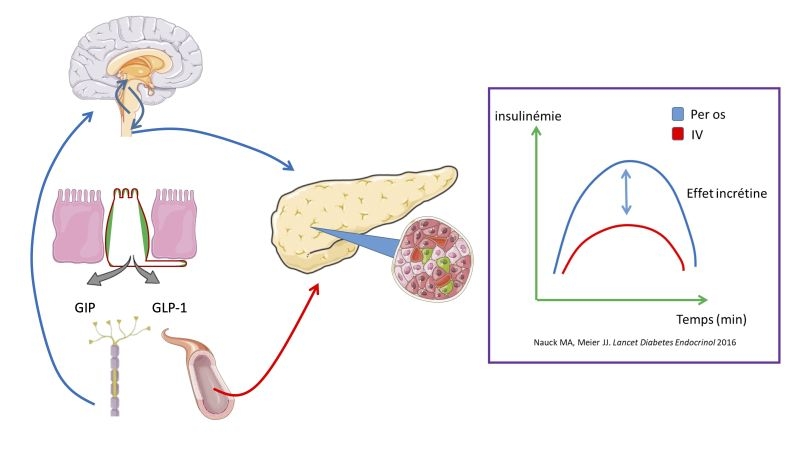| Issue |
Med Sci (Paris)
Volume 40, Number 11, Novembre 2024
|
|
|---|---|---|
| Page(s) | 837 - 847 | |
| Section | M/S Revues | |
| DOI | https://doi.org/10.1051/medsci/2024153 | |
| Published online | 10 December 2024 | |
De la découverte des hormones incrétines aux doubles et triples agonistes GIP / GLP-1 / glucagon
From the discovery of incretin hormones to GIP / GLP-1 / glucagon double and triple agonists
1
Service de diabétologie, CHU Pitié-Salpêtrière, Paris, France
2
Université Paris-Diderot, Unité de biologie fonctionnelle et adaptative / CNRS UMR 8251, Paris, France
L’idée de traiter les diabètes sucrés par des hormones intestinales a été proposée dès les débuts de l’endocrinologie, en 1902, mais ne sera mise en pratique qu’au début des années 2000. La mise en évidence d’une majoration de la sécrétion d’insuline après l’administration de glucose par voie orale par rapport à son administration intraveineuse, connue sous le nom « d’effet incrétine », a été suivie de la découverte des deux principales hormones intestinales responsables de cet effet : le GIP (glucose-dependent insulinotropic polypeptide) et le GLP-1 (glucagon-like peptide-1). La réduction de l’effet incrétine contribue à la pathogenèse du diabète de type 2, ce qui a conduit à développer des thérapies innovantes successives, comme les analogues du GLP-1, les agonistes du récepteur du GLP-1, les co-agonistes GIP / GLP-1 et les triagonistes GIP / GLP-1 / glucagon. Ces médicaments aux effets hypoglycémiants et pondéraux puissants ont modifié radicalement notre prise en charge thérapeutique du diabète de type 2 et de l’obésité.
Abstract
The concept of treating diabetes with gut hormones was proposed in the early days of endocrinology (1902), but was not put into practice until the early 2000s. The discovery of the incretin effect (potentiation of insulin secretion when glucose is taken orally compared to intravenously) led to the discovery of the two main gut hormones responsible for this effect: GIP and GLP-1. The reduction of the incretin effect is directly involved in the pathogenesis of type 2 diabetes, which has led to the development of a series of innovative therapies such as GLP-1 analogues, GLP-1 receptor agonists, GIP/GLP-1 co-agonists and GIP/GLP-1/glucagon tri-agonists. These therapies, with their potent hypoglycaemic and weight-lowering effects, promote optimal control of excess weight and hyperglycaemia, avoiding the escalation of treatment that was once considered inevitable.
© 2024 médecine/sciences – Inserm
Current usage metrics show cumulative count of Article Views (full-text article views including HTML views, PDF and ePub downloads, according to the available data) and Abstracts Views on Vision4Press platform.
Data correspond to usage on the plateform after 2015. The current usage metrics is available 48-96 hours after online publication and is updated daily on week days.
Initial download of the metrics may take a while.





